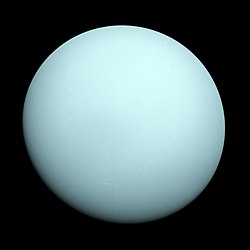Planets/Uranus
Jupiter and Saturn are closer to the Sun than Uranus, and Neptune is farther from the Sun.

Location
[edit | edit source]Sun | Mercury | Venus | Earth | Mars | Jupiter | Saturn | Uranus | Neptune
History
[edit | edit source]Uranus is named after the ancient Greek deity of the sky Uranus, the father of Cronus (Saturn) and grandfather of Zeus (Jupiter). Though it is visible to the naked eye like the five classical planets, it was never recognized as a planet by ancient observers because of its dimness and slow orbit.[1]
Composition
[edit | edit source]Uranus has a complex, layered cloud structure, with methane thought to make up the uppermost layer of clouds.[2] With a large telescope of 25 cm or wider, cloud patterns may be visible.[3] When Voyager 2 flew by Uranus in 1986, it observed a total of ten cloud features across the entire planet.[4] Besides the large-scale banded structure, Voyager 2 observed ten small bright clouds, most lying several degrees to the north from the collar.[4]
In the 1990s, the number of the observed bright cloud features grew considerably partly because new high resolution imaging techniques became available.[5] Most were found in the northern hemisphere as it started to become visible.[5] An early explanation - that bright clouds are easier to identify in the dark part of the planet, whereas in the southern hemisphere the bright collar masks them - was shown to be incorrect: the actual number of features has indeed increased considerably.[6][7] Nevertheless there are differences between the clouds of each hemisphere. The northern clouds are smaller, sharper and brighter.[7] They appear to lie at a higher altitude.[7] The lifetime of clouds spans several orders of magnitude. Some small clouds live for hours, while at least one southern cloud may have persisted since Voyager flyby.[5] Recent observation also discovered that cloud features on Uranus have a lot in common with those on Neptune.[5] For example, the dark spots common on Neptune had never been observed on Uranus before 2006, when the first such feature dubbed Uranus Dark Spot was imaged.[8]
References
[edit | edit source]- ↑ MIRA's Field Trips to the Stars Internet Education Program, In: Monterey Institute for Research in Astronomy. http://www.mira.org/fts0/planets/101/text/txt001x.htm. Retrieved August 27, 2007.
- ↑ Jonathan I. Lunine (1993). "The Atmospheres of Uranus and Neptune". Annual Review of Astronomy and Astrophysics 31: 217–63. doi:10.1146/annurev.aa.31.090193.001245.
- ↑ Nowak, Gary T. (2006). Uranus: the Threshold Planet of 2006. http://www.vtastro.org/Articles/uranus2006.html. Retrieved June 14, 2007.
- ↑ 4.0 4.1 Smith, B. A.; Soderblom, L. A.; Beebe, A.; Bliss, D.; Boyce, J. M.; Brahic, A.; Briggs, G. A.; Brown, R. H. et al (4 July 1986). "Voyager 2 in the Uranian System: Imaging Science Results". Science 233 (4759): 43–64. doi:10.1126/science.233.4759.43. PMID 17812889.
- ↑ 5.0 5.1 5.2 5.3 Sromovsky, L. A.; Fry, P. M. (December 2005). "Dynamics of cloud features on Uranus". Icarus 179 (2): 459–484. Bibcode 2005Icar..179..459S. doi:10.1016/j.icarus.2005.07.022.
- ↑ Karkoschka, Erich (May 2001). "Uranus' Apparent Seasonal Variability in 25 HST Filters". Icarus 151 (1): 84–92. Bibcode 2001Icar..151...84K. doi:10.1006/icar.2001.6599.
- ↑ 7.0 7.1 7.2 Hammel, H. B.; de Pater, I.; Gibbard, S. G.; Lockwood, G. W.; Rages, K. (May 2005). "New cloud activity on Uranus in 2004: First detection of a southern feature at 2.2 µm". Icarus 175 (1): 284–8. doi:10.1016/j.icarus.2004.11.016.
- ↑ Sromovsky L.; Fry P.; Hammel H.; Rages K. Hubble Discovers a Dark Cloud in the Atmosphere of Uranus. physorg.com. http://www.physorg.com/pdf78676690.pdf. Retrieved August 22, 2007.
